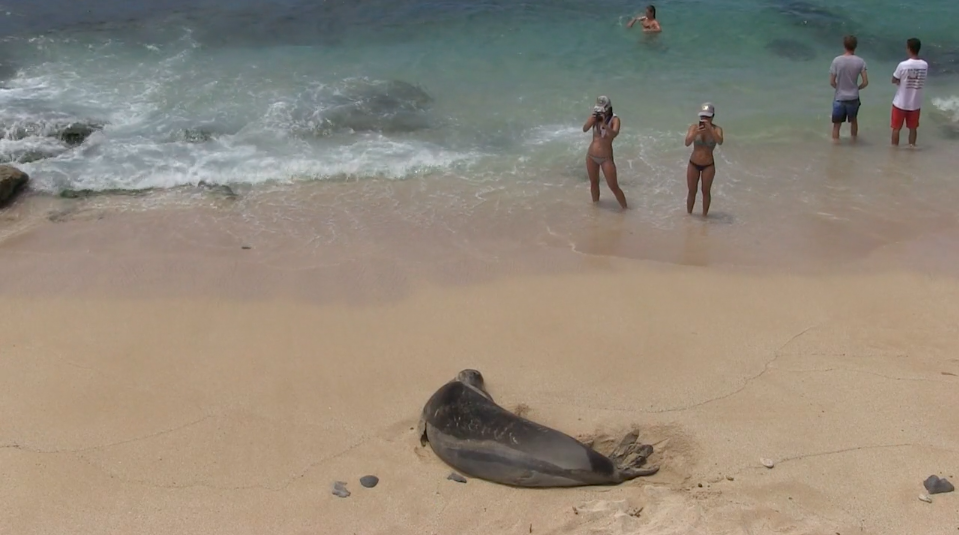08/29/16 – DLNR & YOU – Human Impacts On Hawaii’s Wildlife Resources Public & Private Partners Promote Responsible Viewing
Posted on Aug 29, 2016 in Aquatic Resources, News ReleasesDEPARTMENT OF LAND AND NATURAL RESOURCES
News Release
| DAVID Y. IGE GOVERNOR |
SUZANNE D. CASE
CHAIRPERSON |
For Immediate News Release August 29, 2016
 (Click on image to watch video)
(Click on image to watch video)
HUMAN IMPACTS ON HAWAII’S WILDLIFE RESOURCES
PUBLIC & PRIVATE PARTNERS PROMOTE RESPONSIBLE VIEWING
(Honolulu) – The popularity of self-guided or commercial tours that offer marine-life encounters with turtles, dolphins, whales, manta rays, and even sharks, brings large numbers of Hawai‘i visitors and residents into close proximity with wild creatures. Many people aren’t aware of how their behaviors could hurt them or wild animals, or impact the creatures habitats.
The DLNR, as the state’s leading agency for conservation, management and protection of aquatic species, is working with federal and county partners on strategies to promote responsible wildlife viewing and reduce the impact of marine ecotourism on wildlife.
Bruce Anderson, Administrator for the DLNR Division of Aquatic Resources (DAR) explains, “It’s important for government, scientists and operators to find ways to adequately protect marine species while allowing interactions that are conducted in the right way. Our shared goal is to increase awareness and to build a constituency dedicated to preserving and protecting Hawaii’s ocean resources over the long-term.”
DLNR’s Division of Boating and Ocean Recreation (DOBOR) is holding meetings on the Big Island to determine what protections may be needed to better manage congestion at sites popular for manta ray viewing.
The Department is also supporting a proposed rule by the National Oceanic and Atmospheric Administration (NOAA) which would prohibit approaching a Hawaiian spinner dolphin within 50 yards by any means. This would include commercial swim-with-dolphins programs. Anderson said, “We believe NOAA’s preferred option is reasonable. Two of the five initial alternatives involved closing off entire areas designated as essential daytime habitats. We felt that was going a little too far, but we can support approach rules and eliminating swim-with-dolphins activities.”
DLNR also works with eco-tour land and ocean-based industry groups, such as the Hawaii Ecotourism Association (HEA). It’s the largest group of ecotourism operators in the state. HEA’s Sustainable Tourism Certification Program includes voluntary regional standards that enhance wildlife viewing activities. The program teaches operators how to minimize environmental impacts on fragile marine ecosystems, particularly on near-shore coral reefs and the coastal environments where many marine animals live.
Numerous marine wildlife programs and volunteer community-based stewardship groups also help promote environmental stewardship, and provide a friendly and guiding presence at the most-visited sites where popular marine species such as sea turtles or monk seals come ashore to rest. The threatened green sea turtle is commonly seen in Hawaii’s nearshore waters as well as on the beaches basking, and occasionally nesting. The endangered hawksbill sea turtle (‘ea) is rarer. Hawaiian monk seals have also become more common on beaches in the main Hawaiian Islands. When viewing these and protected species of dolphins and whales, it is important to view them responsibly to ensure your safety and their protection:
- Give Hawaiian monk seals ample space and stay behind any roped off areas
- View sea turtles on land and in the water from a respectful distance of 3 meters
- Remain at least 150 feet from spinner dolphins and other whales and dolphins
- Do not do not chase, touch, or feed any marine life, including coral.
Hawaii’s indigenous marine wildlife, including humpback whales, false killer whales, spinner dolphins and Hawaiian monk seals, are protected by both state and federal laws.
While there is currently no law specifying the minimum distance people can approach a marine mammal, getting close to close to these animals could get you into trouble if the animal is disturbed or if your actions disturb its natural behavioral patterns.
NOAA and DLNR recommend, for your safety and the animals’ protection, that everyone stay at least 150 feet away from marine mammals. If maintaining this distance isn’t possible, keep safety in mind and move away from the animal, avoid sudden movements and other actions that might disturb it.
# # #
Media Contact:
Dan Dennison
Senior Communications Manager
(808) 587-0407
[email protected]
